- Identify a Realistic Keyword Target
- Examine the Most Popular Content
- Create an outline for your Structure
- Value Quality Above All Else
- In-Depth Research of Your Topic
- Provide Answers to Related Questions
- Long sentences, long paragraphs, and misspellings should be avoided
- Use Rich Media to Break Up Your Content
- Confirm that Google understands your content
- Update and revise your Content

There’s no such thing as a shortcut in creating an SEO Copywriting, it is a difficult task that may take a long time, especially if your aim is to rank higher, which necessitates the use of more specialized keywords and strategies. The goal of every content you create is to make it as user-friendly as possible.
Keep in mind to establish a reasonable keyword objective for yourself and familiarize yourself with the algorithms that are crucial in bringing the words together.
In order to grow your blog audience, you’ll need to become more strategic with your content. And SEO copywriting is the primary method for doing this. So, in this article we will focus on discussing SEO copywriting tips to help your content rank.
6 Elements of Copywriting
A copywriter’s grace may be distinguished by the presence of certain aspects of excellent material, such as visual appeal and timeliness. Following search engine optimization best practices continuously throughout your content can organically propel your material into the Google top ten and boost your traffic.
There are, however, certain aspects that will always help you rank well on Google and enhance your conversion rate. Remember that there are things that should come before on-page optimization when using SEO copywriting elements.
Speed of the Website
Sites with a page-load time of more than 2 seconds, which is the industry standard, need to take action to speed things up. Site speed have been a ranking criteria since 2010, as well as advantageous to the end-user experience.
End consumers expect web pages to load in two seconds or less, according to an Akamai research that found that 40% of visitors would leave a website if it takes more than three seconds for the whole page to load.
For this reason: visitors’ attention spans are becoming shorter and shorter, thus they won’t stay on your website if it takes too long to load. Bad user experience is the reason they leave.
To measure your site load time you can use Pingdom’s website speed test. Next thing to do after measuring the speed of your website is to analyze your site speed. The goal is not to exceed more than 2 seconds to achieve the standard load time.
There is a significant connection between site speed and conversion rates, so make sure to keep your audience by creating a fast site load.
Headline
Focus on the things your leads will see first when they are scrolling through the google search results. Your title should catch the attention of your audience and entice them to click and read more about your content.
For search users, headlines that express a meaningful message or concept perform well. A study conducted by Conversion XL claims that headlines with numbers always come on top, especially if it includes a figure in the headline.
In their headlines, a lot of authoritative content sites employ numbers. Three out of every five posts on Lifehack employ numbers in their headlines. Inc, BusinessWeek, Mashable, and Upworthy are all sites that recognize the psychology behind numbers.
If your title is clickable and appealing, it doesn’t matter if you are ranked # or #45in Google’s top 10, because you will still draw organic visitors to your site. A great SEO copywriter, as a rule, starts with the title before going on to the body of your article or blog post.
Although the majority of the search results are SEO-friendly (and target a keyword), some of the headlines are not user-friendly. For those with particular questions, adding a lengthy tail to the title could assist.
Content
When it comes to SEO copywriting, the content is crucial. The main reason people use Google and other search engines is to find helpful information. Fresh SEO material is also favored by search engines, which is why you should update your site on a regular basis.
You must target keyword phrases if you want to generate the perfect content that will rank well in Google. Minimize keyword stuffing and over-optimization. Put the term in the headline if possible, but make sure it flows easily for your visitors.
It’s important to know who your reader is before you start writing your SEO content. Next, narrow your topic and concentrate on a particular topic that the reader is facing. Another purpose of combining SEO and copywriting is to fix that problem with your content.
An appealing introduction is essential for every piece of content you create. The introduction is the paragraph that follows the headline . Put a t least one of your desired keyword phrases in the introduction, preferably a long tail keyword.
It’s essential to realize that today’s SEO copywriting extends beyond keyword targeting and placement. The most effective strategy right now is to create content that addresses keyword intent of the people.
Meta Description
Use meta descriptions to assist guide search engines before writing and again before releasing your content. Meta descriptions facilitate search engines and users in understanding what the topic is and why your targeted keywords and phrases continue to appear in the content.
The meta description HTML property gives a “concise summary” of your page’s content to search engines.
When visitors search for terms that are related to your website, Google utilizes the meta description on your page as a snippet.
This snippet copy, regardless of how high you rank in the search results, is what will determine whether or not you get clicks. And the meta description should be between 150 and 160 characters long for SEO purposes.
Keyword Frequency
The number of times your chosen keywords appear on a web page is referred to as keyword frequency.
Keyword density/frequency is one of the 200 ranking variables, according to Brian Dean, therefore you should still examine it. But don’t go too far.
However, Keyword density and frequency now are no longer as powerful as they were before Google began handing out regular adjustments, but they are still crucial components of SEO material. Minimize the use of keyword stuffing, excessive keyword insertion, and header tag stuffing.
To evaluate if your keyword repetition is excessive or spammy ,compare it to the total length of the text. A keyword density of more than 5.5 percent may constitute keyword stuffing, and your website may be punished by Google. Use the SEObook keyword density tool to assess your keyword density.
Page Links
Page links inform Google that you’re engaging and connected, and that you have good information that others can obtain elsewhere. It’s possible that this content is your own or that it came from another author or website.
The fact that you link to other authoritative sites and pages shows that you value what others have contributed. Google will reward you for supporting their aim of organizing and making the world’s knowledge broadly accessible. Appropriate linking is definitely recommended by a professional marketing team.
There are no clear rules when it comes to linking to other websites. Internal linking has no particular rules, either.
However, if you’re a savvy web marketer that wants to dominate the search engines, you should:
- In your introduction, include links to pertinent sites both inside and outside your site.
- On your page or on other sites, include links to further in-depth instructions or material.
- Use proper anchor language that goes organically with the content to create a link.
These guidelines aren’t established by Google or other search engines. You won’t have to worry about keyword density, page links, or social signals if you understand your target audience and create the finest content that solves your readers’ concerns.
As an SEO copywriter your job is to reach thousands of social shares, comments, leads, clients, and sales.
Top 10 SEO Copywriting Tips to Help You Rank
Discover these easy to follow tips that will help skyrocket your ranking into the top of search results. Make sure to be consistent in all these:
1. Identify a Realistic Keyword Target
The basis of SEO copywriting is keyword research. Your keyword target should be defined prior to the beginning of writing. So, make sure you establish reasonable and attainable keyword targets for your content.
Choosing industry keywords with a greater search volume may seem like a good idea, but such terms are frequently incredibly competitive.
In the case of a website with less authority, it is unlikely that you would rank on the first page of search results for certain phrases, no matter how good the quality of your content is.
To help you achieve your keyword objectives, you may utilize keyword difficulty ratings to create benchmarks for yourself. Find relevant keywords with difficulty ratings that are less than or equal to your site’s in order to give your content a better chance of ranking well on search engines.
Despite the fact that certain keywords are long-tail or have more informative search intent, they may provide substantial potential for your content to rank rapidly and begin generating traffic.
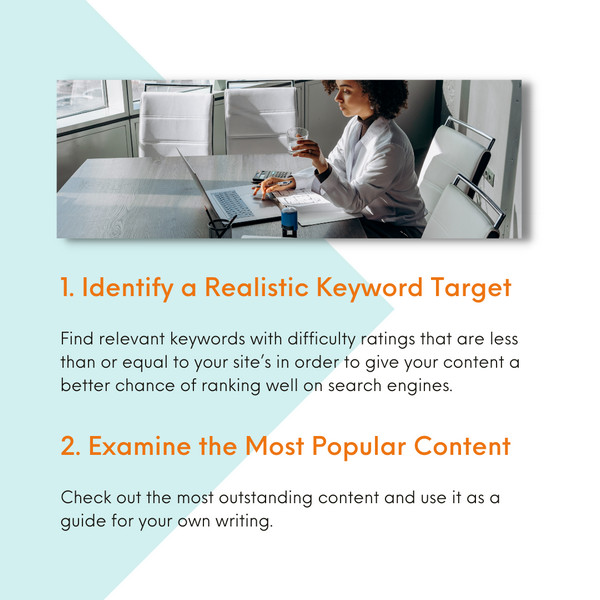
2. Examine the Most Popular Content
Check out the most outstanding content and use it as a guide for your own writing.The objective isn’t to make an exact copy of your competition, but to learn more about what content, authority, and page experience signals Google crawlers react to.
3. Create an outline for your Structure
Although no two content outlines will be precisely the same, the goal is to define the overarching theme, subtopics, headers, and important points that will be covered in the content and how they will be organized.
Your keyword objectives should be prominent in these structural components if you’re optimizing effectively. Although not all copywriters like to work from outlines, they may be quite helpful in ensuring effective on-page SEO.
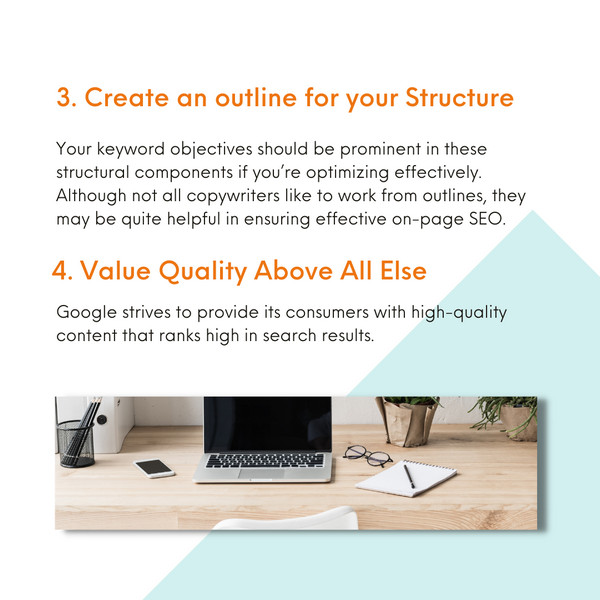
4. Value Quality Above All Else
Google strives to provide its consumers with high-quality content that ranks high in search results.
But what exactly is “quality” ? Relevance, load speeds, backlinks, and referring domains are just a few of the factors considered.
According to Google’s definition of quality signals that are transmitted via writing, the following are indicators of high quality:
- Content that is comprehensive and in-depth.
- Reporting and analysis that is unique.
- Authorship and sourcing by subject matter experts.
- Proper grammar and spelling
5. In-Depth Research of Your Topic
If you use keyword tools, they may assist you in expanding on your content by displaying the subtopics that are related to your primary keyword objective.
Despite the fact that content length is not a ranking criterion, there is a substantial link between longer content and higher ranking positions on search engines.
This is due to the fact that longer content is more likely to include the quality signals . Additional research has shown that lengthier content is more likely to get backlinks and generate social media interaction.
As a result, make every effort to be comprehensive and carefully review your contents.
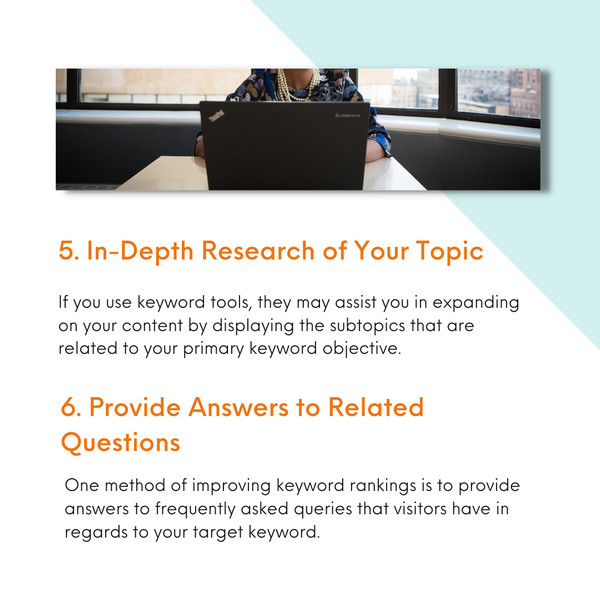
6. Provide Answers to Related Questions
One method of improving keyword rankings is to provide answers to frequently asked queries that visitors have in regards to your target keyword.
If you want to know what these questions are, there are a few of methods to find out: Google Search as well as a keyword research tool.
Consider the opinions of others as well. Using the Ask and Autocomplete features, you may find out what typical queries people have regarding the issue. Then, make certain that you include those queries as well as their solutions within your written content.
In a similar manner, certain keyword tools can tell you what the most often asked queries are by searchers.
7. Long sentences, long paragraphs, and misspellings should be avoided
When it comes to readability, you want your content to be readily understandable by a wide range of readers. If your information is overly scholarly or technical, some readers may prefer to return to the search engine results page (SERP).
The same is true for material that is badly written or full of mistakes, which will discourage readers. So, to make reading more enjoyable, make your phrases and paragraphs as short as possible.
Although some SEO tools recommend a grade level, the goal is to make the language as basic as possible and accessible to the greatest number of individuals.
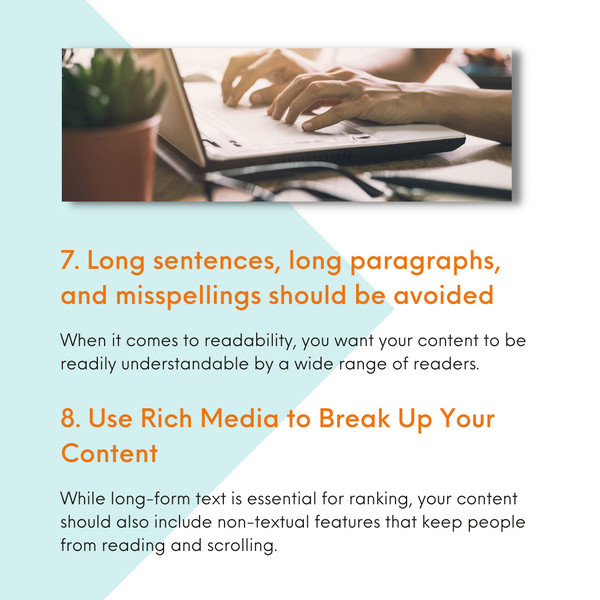
8. Use Rich Media to Break Up Your Content
While long-form text is essential for ranking, your content should also include non-textual features that keep people from reading and scrolling.
Offer a content that includes photos, videos, or infographics, especially to break up lengthy paragraphs of text. Rich media material is preferred by Google, so use it to your advantage.
Rich media, on the other hand, might work against you if it slows down the performance of your sites. As a result, be sure that any rich media you use is optimized for speed and efficiency.
9. Confirm that Google understands your content.
Log into your Google Search Console account a week or so after you post your content to ensure that Google is properly interpreting your work. Check out which keywords are generating the most views for you.
It’s excellent if they’re close to or related to your initial keyword target. If not, the material may need to be revised.
The accumulation of higher rankings and clicks will occur with the passage of time and the development of authority, but impressions are an early indication that Google understands your content and knows when to push it.
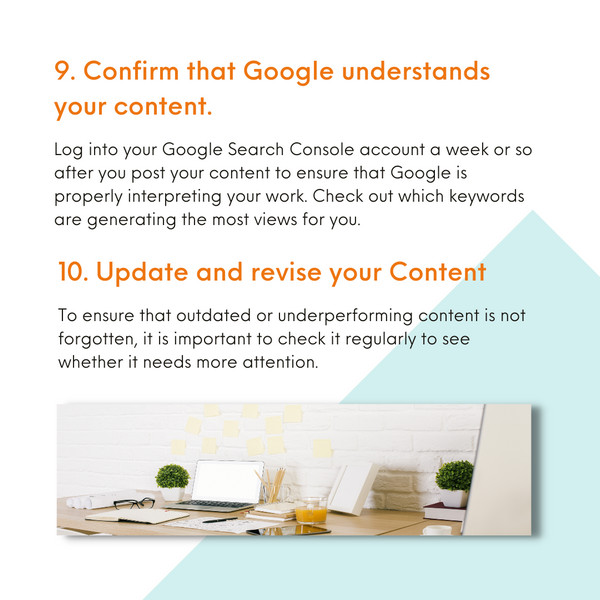
10. Update and revise your Content
Your content will inevitably become outdated over time. It’s possible that new information may become accessible, that keywords will become more competitive, that links will break, and so on.
To ensure that outdated or underperforming content is not forgotten, it is important to check it regularly to see whether it needs more attention.
Especially if they are addressing industry trends or analyses, it is recommended that your most significant content assets be updated at least once a year.
Conclusion
The intent is the most crucial part of every keyword used by searchers. You need to know what each keyword stands for before you can develop outstanding content that answers a specific problem. And since the internet is always changing, and algorithms are constantly evolving, thus the need for your content to be updated to keep up.
By constantly updating and adding new information, you can extend the lifespan of your content and ensure that it continues to rank well for relevant keywords for years to come.

Bea Manzano
Bea have always been passionate about writing even at a young age. What started out as a hobby soon became her career. She has written blogs and articles for different industries such as Real Estate, Lumber Companies, Home Decors, Cat Hotels, Travel Industry, and many more. When she's not writing, you can find her either at home watching her favorite TV series while sipping milk tea or outdoors going on roadtrips with her family.













